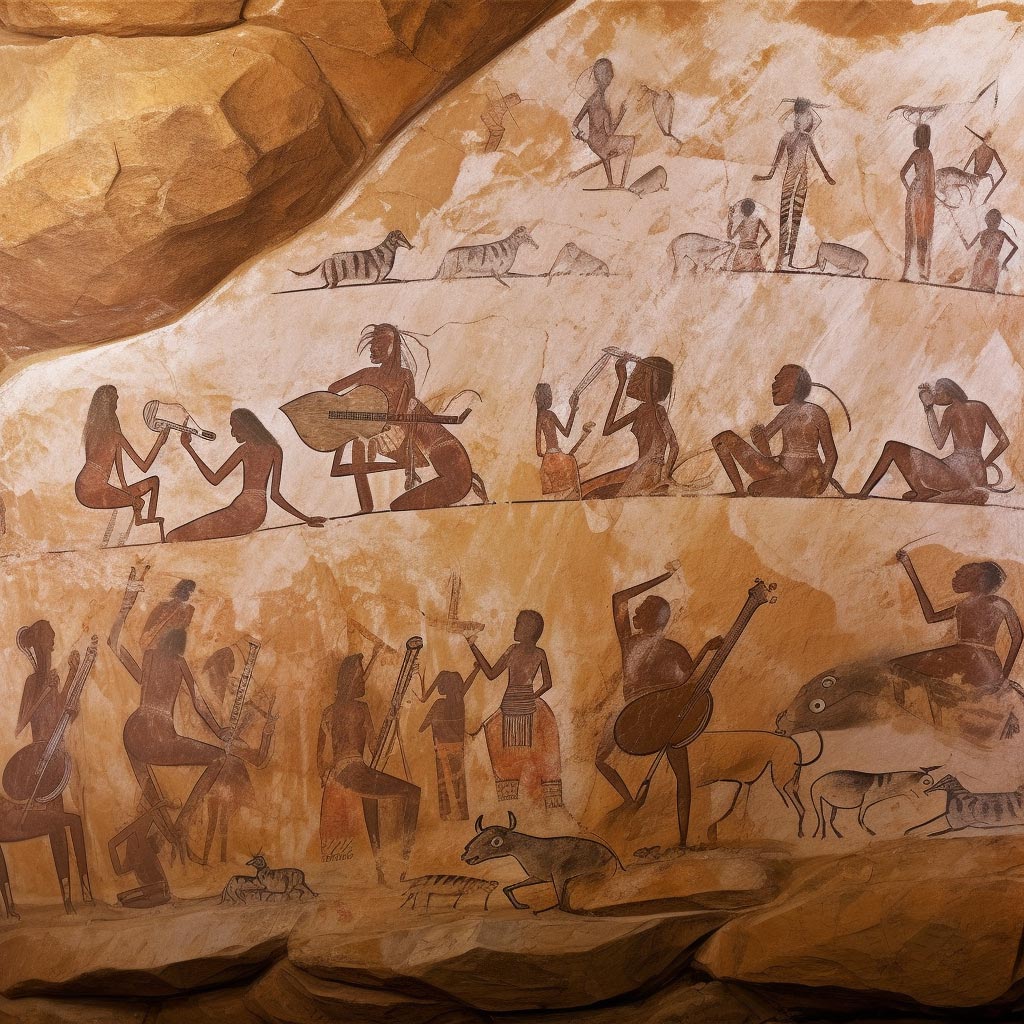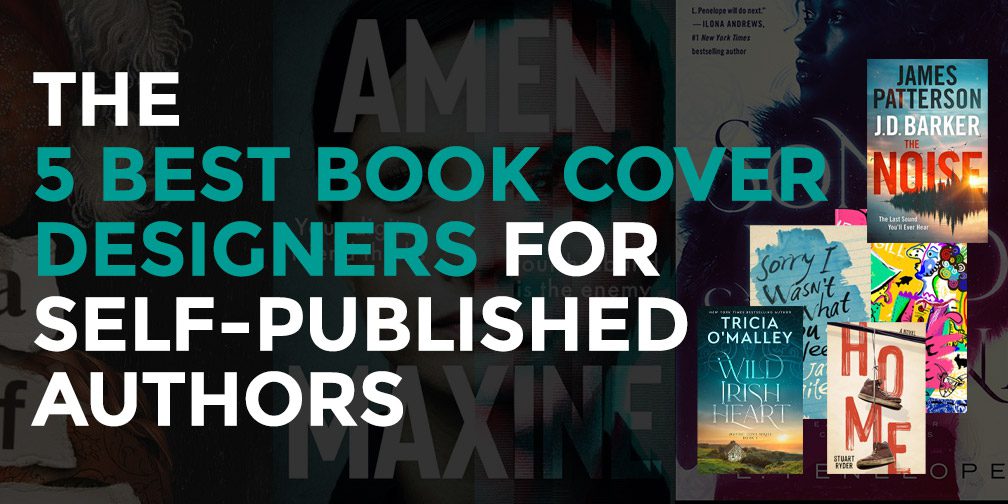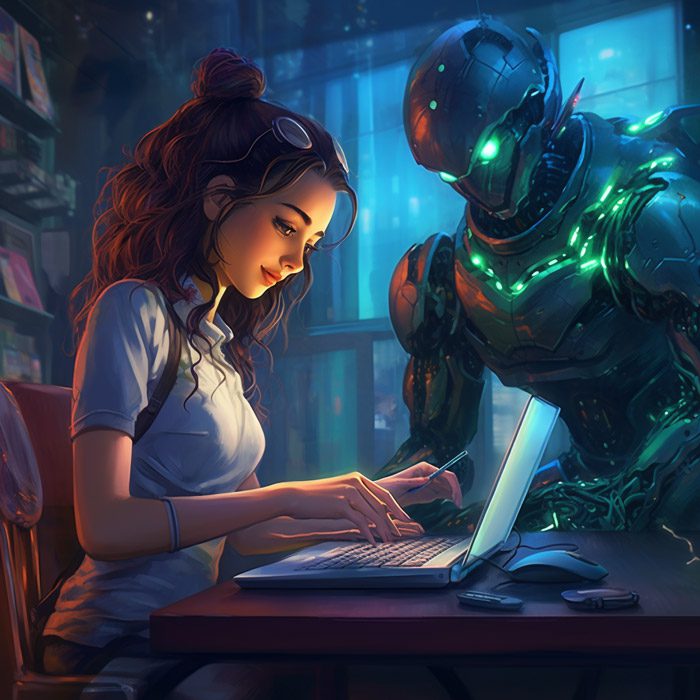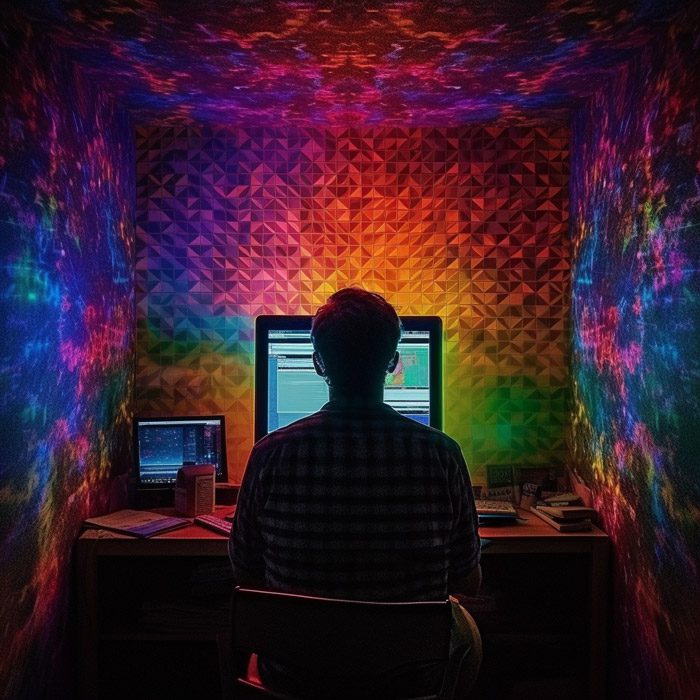It’s come with a rush.
Between ChatGPT and image generators like Midjourney and DALL-E, we now find ourselves in a world unrecognizable from the one we called home just 12 months ago.
If, in early 2022, you gave me two minutes to write 500 words on the impact of Elton John on eyewear culture AND create an image of Joe Rogan sitting in broth, I probably would’ve struggled. I no longer do.
As amazing as all this is, it can feel a little uncomfortable, and more than a little disconcerting, to the creatives in the room. Many professionals – writers, artists, coders, designers and more – are working to understand where technology fits into their process, what to keep human and what to delegate to machine, or indeed whether to engage with the technology at all.
It’s something I’ve been grappling with myself. And I feel that there’s no better time than now to discuss how AI might affect book cover design, and how we’re planning for this future at Damonza.
AI art: new, amazing, divisive, and here to stay
I’m in the book cover design business. Not engaging with AI isn’t really an option: I have a business to run, employees to support, a future to secure. To stand still is to move backwards, the early bird gets the worm, insert generic inspirational corporate quote here.
I’ve spent months thinking deeply about the topic of AI image generation and book cover design. I’ve looked at it from all angles, I’ve dissected and gutted it, and I’ve placed samples under the microscope for closer inspection.
No matter what your personal feelings toward AI might be, there’s one thing that we can all agree on: it’s going nowhere. The world’s biggest companies are in a veritable fit trying to maximize their slice of the generative AI pie. This isn’t some off-Broadway production, a sideshow whose time will come and go; it’s here to stay, and as billions continue to be poured in by investors, it will only get herer to stayerer.
So let’s take a look at the realities of this new reality.
The basics of novels, book covers and copyright
If you’re a self-published author you’re more than likely aware that you can copyright your work. In fact, it’s rather easy:
But copyrighting a novel and copyrighting a book cover are very different things. This is because novels and book covers are made of very different things.
Novels are made of raw materials called ‘words’, and no one can own a word. (Before you say it, there’s a BIG difference between copyright and trademark.) That means you’re allowed to use all the words, from aardvark to zyzzyva, in your manuscript. When you place these words in a certain order – one never previously imagined – you can secure a copyright on the resulting work.
Book covers, meanwhile, are made by combining a number of creative materials like fonts, design elements, stock photos and imagery. Unlike the words that make up a book, the person who created that font, designed that element or took that photo owns the copyright to it. It is up to the creator to decide whether they will allow others to use their work for a book cover.
This is actually a very important part of what book designers do. We ensure that every element used on a cover is appropriately licensed, allowing you to sell your book freely wherever you might choose.
So can you copyright that cover? We’re afraid not.
To obtain copyright you need to be able to demonstrate that you are the original creator of the design, or that the design you have created is so original and unique that it transcends the fact that you have used copyrighted elements within it. This bar is almost impossible to Fosbury flop your way over.
The only real way to copyright your cover is to find an artist/designer/photographer who creates something truly unique and who is willing to hand over the copyright, while staying away from using any pre-existing elements (including fonts). This isn’t something that most self-published authors can afford to do, and is the very reason that Damonza exists.
We build beautiful book covers from disparate elements, we ensure everything is above board, and we do it all for the right price.
But the rise of AI image generation has put our current modes and methods in the cross-hairs.
The great AI debate: machine creation vs human originality
What is AI-generated art? We won’t take a deep dive into how the technology works, because it’s complicated, for our purposes we simply need to know that it trains itself as an artist using huge databases of images.
Many people are concerned, and not without reason, that these training images were used without permission from copyright holders. This leads many people to assume that generative AI simply pieces existing images together to make a ‘new’ image, or worse, that it copies works directly, and therefore violates copyright laws.
But the truth is that generative AI doesn’t produce collages or copies – it creates things that are entirely new. This hypothesis is simple to test: we can ask it to create something that has never existed before, like:

A rock painting of a rock concert.

A photo of a Roman Emperor playing disc golf.

A gangster flamingo with a mullet riding a motorbike.
Each of these ideas fell directly from my head onto the keyboard, and it’s difficult to argue that the results aren’t unique and original.
In reality AI works in much the same way as artists and book cover designers have always worked. It studies trends, learns techniques and gains inspiration, just as all creatives study trends, learn techniques and gain inspiration.
Close your eyes and imagine a cover for a suspense novel. Did your brain conjure up a dark background and a bright sans serif font? At some point, a person was the first to create this very recognisable motif, but did they ever give permission to the thousands of authors and designers who have used it since?
As Voltaire so aptly put it, originality is nothing but judicious imitation.
For all intents and purposes, AI creates new images from scratch. For the moment, however, the results cannot be copyrighted – the US copyright office has stated that images must be created by a person to be considered original work. But as we mentioned previously, this isn’t much of a change to the book cover industry, as any cover that features an already copyrighted element – the overwhelming majority of covers – can’t be copyrighted again anyway.
So what’s the deal with licensing and AI images?
If AI-generated images cannot be copyrighted, the most important question for self-published authors is whether you’re allowed to use these images on your cover. We’re looking for the same permission we get when we use stock images from a royalty-free database – we’re given the right to use the images in a commercial capacity, without fear of retribution.
The good news is that the major AI image generators grant their paying members this right – any image a user creates is free to be used by its creator in book cover art, marketing materials, social posts and more.
Keeping it real: our responsibilities when using AI
As I telegraphed at the top, I’ve thought deeply about AI. Initially I was concerned for the future of our business, but I soon came to realise that AI, like stock image databases and Photoshop, would simply be another tool in our toolkit. We’ve already been able to eliminate our “character creation” fee, as generative AI has made it possible to create truly unique and entirely customisable characters in a few clicks.
AI image technology overwhelmingly affects artists and designers, who have previously held an exclusive ability to create the images that AI now learns from. I have no doubt that a good portion of the 10,000+ book covers we have produced have been used to train AI, and I could easily mount a case for victimhood. But when a ‘victim’ like me is embracing the technology, there’s probably something to be said for it.
Book cover design is an art that extends far beyond image generation, and I see the introduction of AI image generation as an overwhelmingly good thing. You can read more about new policy on generative AI here, and I’ll be covering this in more detail in articles to come.
But I understand that some of my clients won’t share my views, which I appreciate and respect. With that in mind, we’ve developed some policies designed to offer clarity and choice to authors who work with us:
-
Only separate elements will be generated, never the entire cover.
-
AI elements will be combined with traditionally licensed royalty-free stock photos and text.
-
No real people or artists will be used as part of image generation prompts.
-
All AI images will be generated privately – they will be unable to be accessed by anyone else.
-
All AI images are created with a commercial licence for use on book covers.
It’s a start, and as generative AI continues to develop, so too will our policies.
But enough of all the rules and regulations. Now that we have gained an understanding of generative AI and book covers, and our approach to the technology, the next question is how? How does generative AI fit into our toolbox?
It’s a subject that I feel deserves its own article, which will be the subject of my next post.








3 Responses